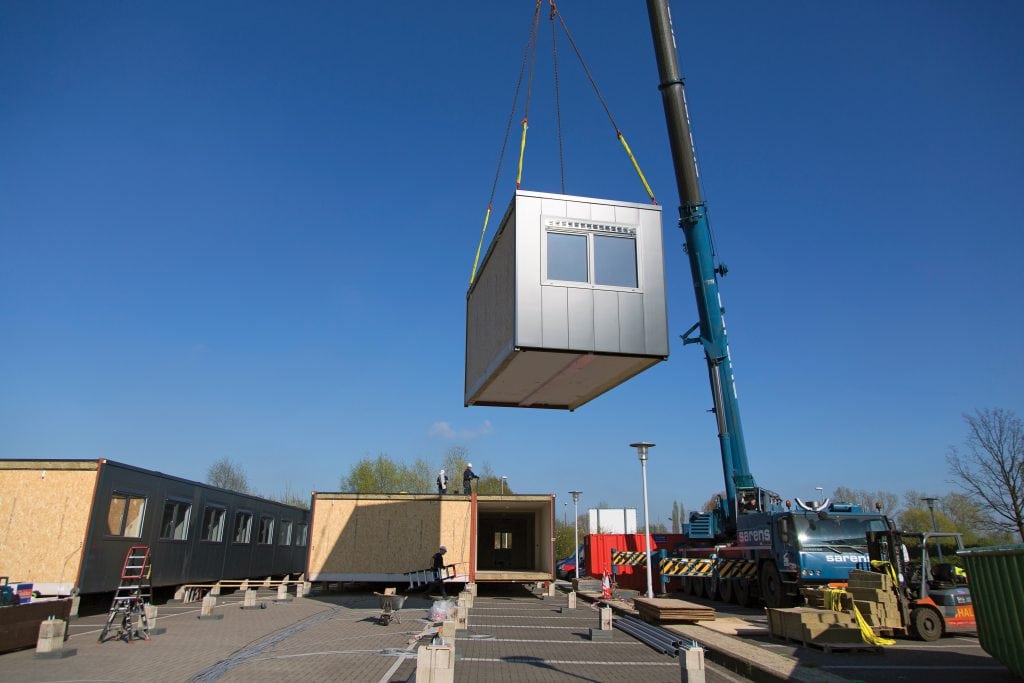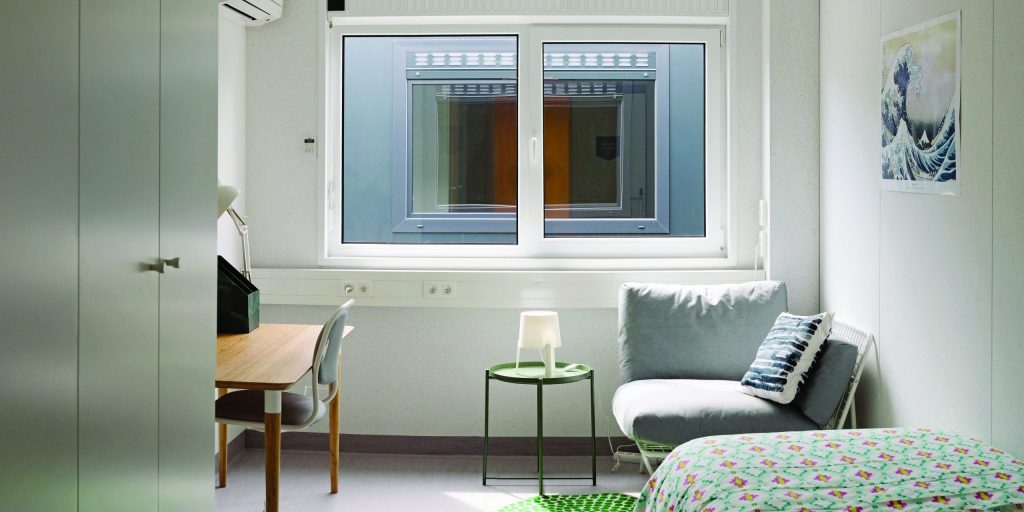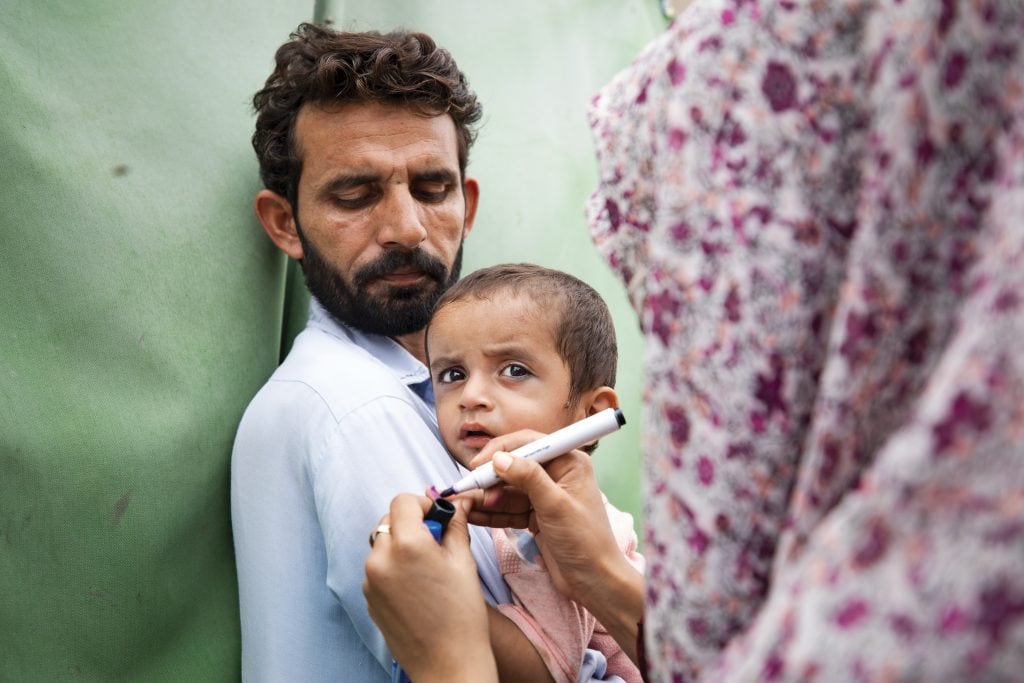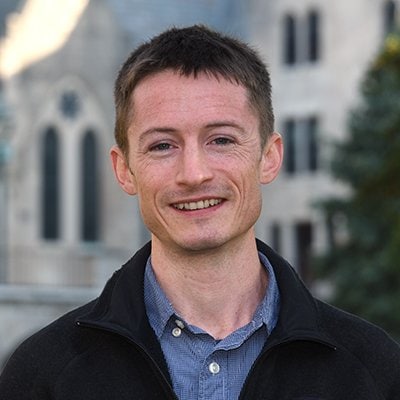This story originally appeared in the October 2022 issue of Rotary magazine.
In mid-2017, two groups of 15 strangers lived together for 28 days each in a ring of shipping containers assembled in the parking lot of Antwerp University Hospital in Belgium. They had access to books and movies, a small courtyard for barbecues, a common kitchen and dining room, and a fitness room — all of it behind secure interlocking doors and under the watch of personnel in protective gowns.
What sounds like a reality TV or sci-fi scenario was, in fact, a remarkable clinical trial of the latest weapon in the battle to eradicate polio — a reengineered vaccine called the novel oral polio vaccine type 2, or nOPV2. The study aimed to evaluate whether the altered formula, the first major update to polio vaccines in about six decades, could help end outbreaks of circulating vaccine-derived poliovirus, also known as variant poliovirus. Such cases arise in rare instances when the live but weakened virus contained in oral polio vaccines circulates in areas of low vaccine coverage and mutates back into a dangerous form that can infect people who have not been fully vaccinated.
These variant poliovirus outbreaks have emerged over the past two decades as a significant stumbling block in the effort by Rotary International and its partners in the Global Polio Eradication Initiative (GPEI) to wipe out the disease. The outbreaks are different from those driven by wild poliovirus, which circulated naturally in the environment for millennia and remains endemic in just two countries, Afghanistan and Pakistan. But the outcome is the same — the virus in either kind of outbreak can, in rare instances, cause paralysis.

In 2011, staff at the Bill & Melinda Gates Foundation, one of the GPEI partners, wondered if the live virus in the traditional oral vaccine could be tweaked to limit its ability to mutate. “The first challenge was purely scientific,” says Ananda Bandyopadhyay, a deputy director of the polio team at the Gates Foundation, which funded and led the effort. “How do you make the vaccine more genetically stable without compromising its immunogenicity [ability to provoke an immune response]? That was really, really challenging.”
Even then, researchers would need to figure out how to test vaccine candidates. Any attempt would require strict isolation of study participants. At a 2015 meeting in Brussels, Bandyopadhyay pitched the audacious idea to Pierre Van Damme, director of the Centre for Evaluation of Vaccination at the University of Antwerp. “We had to be very creative,” says Ilse De Coster, who would lead the clinical trial team with Van Damme in Belgium, “because at that time we didn’t have any facility that was developed for containment.”
They considered sequestering study participants at isolated holiday resorts or vacant centers that had been used to house asylum seekers, eventually settling on the idea of a purpose-built modular container village, dubbed Poliopolis by Van Damme’s wife.

For much of the developed world, polio is a distant memory. Long gone are the days of the summertime terrors in Europe and North America in the 1940s and 1950s when children went to bed with what their parents thought was a mild flu only to wake up rubber-limbed and burning with fever. Thousands were paralyzed. Some ended up in the dreaded iron lung device that enclosed the body up to the neck and helped them breathe. There is no cure for polio, but with the development of vaccines in the 1950s and subsequent routine immunization, many countries have not seen a case of wild poliovirus in decades.
In 1988, wild poliovirus paralyzed hundreds of children every day, with an estimated 350,000 polio cases across more than 125 countries that year. Since then, cases have plummeted 99.9 percent. That progress would not have been possible without the oral polio vaccine. “It’s a critically important tool and has saved millions of lives,” Bandyopadhyay says.
The oral polio vaccine, or OPV, was developed in the late 1950s by physician Albert Sabin. It’s become the vaccine of choice for polio eradication because it’s safe, inexpensive and easy to administer, and the live but weakened vaccine virus replicates in the gut and produces strong intestinal immunity. As a result, vaccinated children can shed the weakened vaccine virus in their stool for several weeks. In areas with poor sanitation, the weakened virus spreads, stimulating an immune response in the unvaccinated. But this ability of the weakened virus to circulate carries the risk of seeding vaccine-derived, or variant, outbreaks in areas of low immunity.
Most variant cases involve type 2 poliovirus, one of two strains that have been eradicated in the wild. The number of children paralyzed by the type 2 variant poliovirus surged from two in 2016 to more than 1,000 at its peak in 2020, spread over two dozen countries, most of them in Africa.
The existing oral polio vaccine containing only type 2 virus has been effective in stopping most variant poliovirus outbreaks. Still, that vaccine carries the risk of the virus mutating. At the Gates Foundation, there was a realization that a new type 2 oral polio vaccine was needed, and fast.
Crushed by negative news?
Sign up for the Reasons to be Cheerful newsletter.The foundation established and funded a scientific consortium to develop the new oral vaccine, including the UK’s National Institute for Biological Standards and Control and the University of California San Francisco. Researchers at those two institutions altered part of the old type 2 vaccine virus’s genome to make it more genetically stable while preserving its ability to produce strong immunity in the gut. But the challenge of how to test it in humans without risking environmental spread remained.
The team at Poliopolis was moving fast. The 66 containers, which were prefabricated off-site, were assembled in just three days in April 2017 and were ready for operation a month after that. To the researchers’ knowledge, no one had ever attempted a containment study in such a purpose-built facility and for so long.
Because of the length of time the virus can continue to be excreted, trial participants would have to stay sequestered for at least 28 days. Volunteers had to undergo medical and psychological screening to ensure they were up to the challenge and could function as a group.
Volunteers, most from neighboring Netherlands, got along well despite occasional friction. “Put some people together and there will be friction, like on the reality TV show Big Brother,” explains Caro Bouten, one of the volunteers. “I was writing a book, so I didn’t care. I’d go back to my room. I had a focus. So that helped me.”
Polio left Bouten’s aunt with a limp, a leg brace, and a difficult life at a boarding school, separated from a family that felt ashamed of the condition. Those memories, along with her work as a nurse and counselor for refugees, motivated her to join the study. She realized just how important it was afterward when she was invited to meet the queen of Belgium.

The vaccine trials were a success and NOPV2 was rolled out in March 2021, first in Nigeria and Liberia. Through the first half of 2022, more than 370 million doses were administered in more than 20 countries.
“It’s looking very promising, and it’s looking like it’s doing what it is supposed to do: induce population immunity and interrupt transmission in most settings and with a much lower risk of seeding new outbreaks,” Bandyopadhyay says.
The new vaccine, by itself, is not a silver bullet. It won’t stop transmission if immunization campaigns cannot reach close to 90 percent of children in the response zones. Under-immunization remains an obstacle, allowing cases of variant polio to leap across the globe and pop up in places where the disease hasn’t been seen in years. Officials detected polio in London and New York City sewage this year, for instance. And in July 2022, health authorities announced an unvaccinated man in New York state had been sickened with variant poliovirus genetically linked to the spread in London.
Like many polio campaigners, Nana Yaa Siriboe, a member of the Rotary Club of Accra Labone, Ghana, has a personal stake in crossing the finish line. Her cousin is a survivor who once needed crutches but now walks unaided, with only a limp.
Siriboe became chair of the Ghana PolioPlus Committee in 2019, just as variant polio cases were emerging in the country, about a decade after it was declared polio-free. She mobilized Rotary volunteers to visit homes, schools, mosques, churches, and markets to find and immunize children, and the outbreaks were suppressed for two years. But polio paralyzed one person this June, prompting another mass immunization campaign that was to start in August.
The arrival of nOPV2 gives her hope. So do the mothers she has watched over the years bringing their children to be vaccinated. “It’s a joy,” she says of meeting the children. “You get to play with them. Some like to see their little finger marked with the pen to show this child has been immunized. We give them toffee. It’s a wonderful experience.”








